- Home
- Encyclopedia
- Trade Among Tribes: Commerce On The Plains Befo...
Trade Among Tribes: Commerce on the Plains before Europeans Arrived
In the spring of 1934, an aging cowboy and stockman wrote some recollections to the editor of the Lusk Free Lance, a newspaper then published in Niobrara County in eastern Wyoming. In his letter, Addison A. Spaugh detailed his extensive life in the Wyoming cattle business, including a discovery he made in 1880 while driving cattle up the Muddy River drainage in the foothills of the Laramie Range.
“It was on this trip up the Muddy I discovered the Spanish Diggings. Thinking I had discovered a Spanish gold mine, I reported the fact to Mr. Manville [Hiram S. Manville, co-owner of the Converse Cattle Company] and he reported it to Adams and Glover, two drug store men in Cheyenne …”
The name, Spanish Diggings, stuck. Assumptions about its origins did not. Archeologists and geologists were the first to call Spaugh’s assumptions into question. In 1894, University of Wyoming Geology Professor Wilbur C. Knight examined the quarries and estimated that “aborigines” excavated “hundreds of thousands if not millions of tons,” of quartzite.
Knight made no reference to the Spanish or any other European settlers.
Eventually, archeologists would confirm that Spanish Diggings is a 400 square-mile series of Paleo-Indian quarries, dating to 10,000 years ago. As Gene Gade, president of the Vore Buffalo Jump Foundation, notes, “It was slowly accepted that the ‘Spanish Diggings’ were, in fact, the work of groups of hunters that had lived in the region and quarried the stone for projectile points, knives, scrapers, and other tools.”
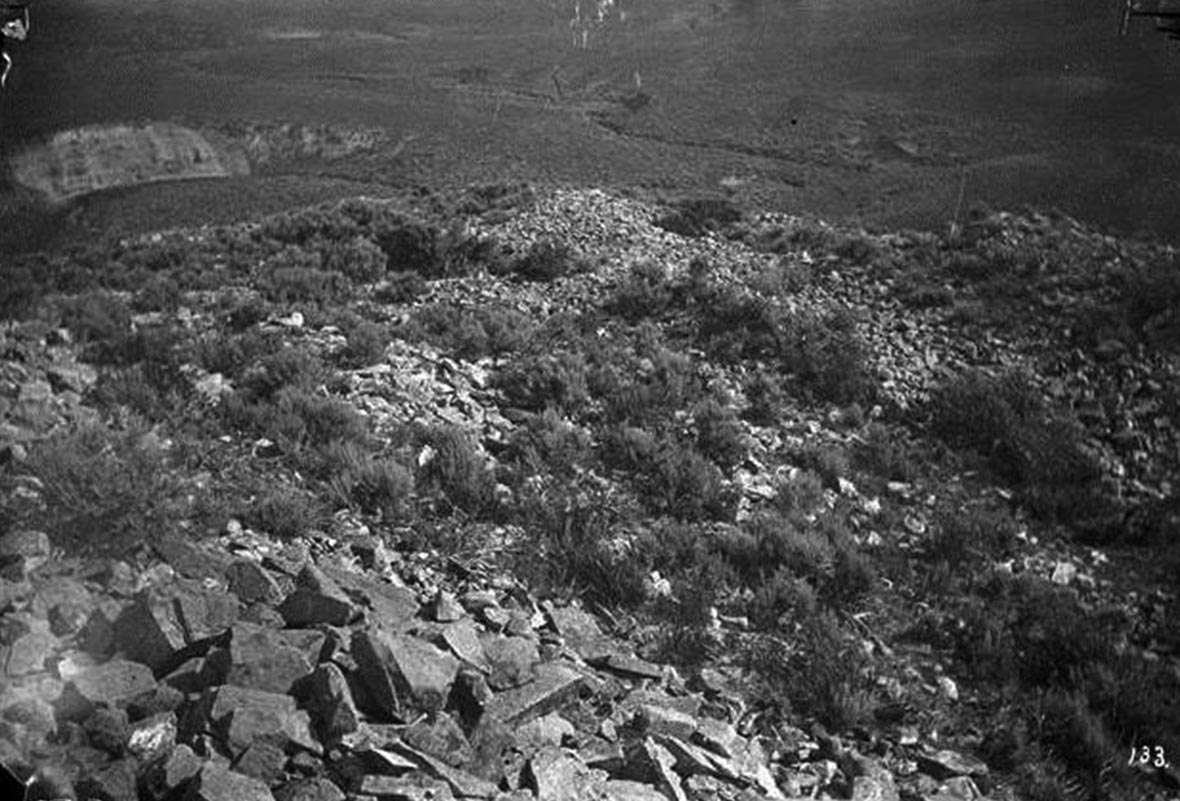
Trade among tribes of the Plains
A general misperception of Native American enterprise and trade continues today. On the Wikipedia page on Indian Trade, the discussion centers on Native American interactions with the English at the Jamestown colony in Virginia, general information about tribes involved in the Canadian-Missouri fur trade, and explains how some California tribes gathered slaves for the Spanish. The page omits any references to or examples of tribe-to-tribe trade.
Indians of the southern and northern Plains traded with each other for thousands of years. Flint points 13,000 years old, chiseled from the Texas quarries, have been found in eastern New Mexico. Quarried stone from the Obsidian Cliffs near Mammoth Hot Springs, Wyo. in Yellowstone Park, traveled to the the Ohio River Valley around 100-350 CE.
While archeological objects abound in Wyoming, the artifacts alone don’t tell the story of pre-settlement trade among nomadic Plains tribes. Moreover, even before the advent of Europeans, tribal boundaries fluctuated with weather, game populations and alliances with other tribes. For example, the Comanche, one of the most entrepreneurial of tribes, once were part of the Shoshone tribe and lived largely in what's now Wyoming. In the middle 18th century they split from the Shoshone and moved south to rule the plains of Texas and Oklahoma.
Archeological artifacts do suggest, however, that native-to-native trade expanded over time. Emory Dean Keoke and Kay Marie Porterfield, authors of the Encyclopedia of American Indian Contributions to the World, say that the Hohokam tribe, centered in present day Arizona, traded seashells, which they had acquired from the Mojave tribe, for buffalo hides from various southern Plains tribes. “By between 500 and 200 B.C., North American Indians had established a vital network of trade.”
Those networks weren’t equally distributed, however, on the central plains.
Wyoming’s role in tribal networks
The center of Wyoming, close to modern-day Lander, is isolated and roughly 800 miles equidistant from the three major pre-settlement trading centers for tribes: The Dalles, where the Chinookan tribes gathered along the Columbia River in what’s now Oregon; Taos Pueblo in present New Mexico, which serviced the tribes of the southwest; and the Mandan/Hidatsa trade center, where the Knife River joins the Missouri River in modern-day North Dakota, where northern Plains tribes came to trade (see map).
There were also trade centers further south along the Missouri in what’s now South Dakota– the Arikara Center and the Dakota Rendezvous – that attracted mostly tribes from the southern Plains.
It would be reasonable to assume that entrepreneurial tribes inhabiting Wyoming faced the same obstacles as a modern Wyoming business in creating a trade hub: distance to markets, lack of a critical mass of customers, and inclement weather. That may be true.
Wyoming, however, was home to at least two enterprising tribes, the Crow, and particularly the Shoshone, who had their own trade fair, the Shoshone Rendezvous.
We know little about this event, including its exact location. The recognized authority on the Shoshone Rendezvous, Smithsonian ethnologist John C. Ewers, wrote in the early 1950s that the most likely location was in “in the river valleys of southwestern Wyoming west of the South Pass—“a description that would also fit the later, better-known fur trade rendezvous of 1825-1840.
Ewers’s main source is Canadian fur trader M. Charles McKenzie’s narrative, “The Mississouri [sic] Indians. A narrative of four trading expeditions to the Mississouri, 1804, 1805, 1806, for the North-West Company.”
Tribes, aiming for handsome profit, would buy items from the either the Mandan/Hidatsa Center or the Dakota Rendezvous and transport them to southwest Wyoming each spring.
Relying on McKenzie, Ewers notes that in June 1805, the Crow traded 250 horses to the Hidatsa, who offered 200 guns in exchange. The next year the Hidatsa offered 200 guns to the Cheyenne, hoping to receive at least that many horses in exchange. Normal markups were 100 percent; the Crow sold horses to the Mandan and Hidatsa at twice the price they had paid at the Shoshone rendezvous. The river tribes doubled the prices again when trading with others, like themselves, on the upper Missouri.
W. Raymond Wood, professor emeritus of anthropology at the University of Missouri,said that long before the advent of Europeans the Shoshone Rendezvous served as a trade link between tribes of the Pacific Coast and tribes of the upper Missouri.
“Crow Indians,” writes Wood, “carried goods to this rendezvous from the northern plains; Utes brought goods to it from the Southwest; and the Shoshone, Nez Perce, and Flatheads brought goods from the Great Basin and Plateau.”
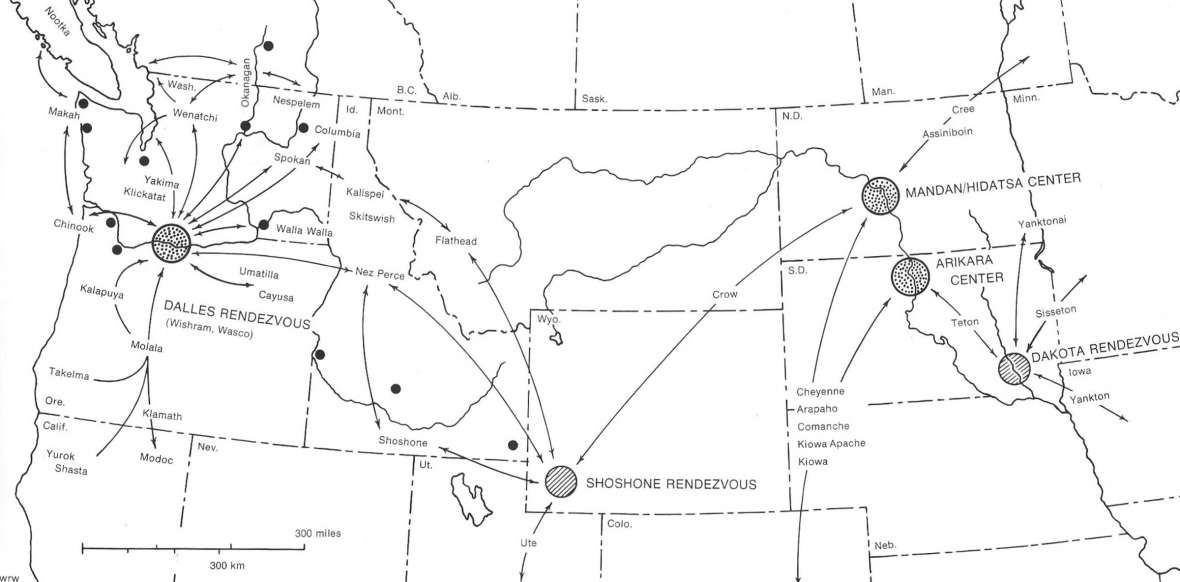
The Shoshone Rendezvous eventually gave way to the Green River Rendezvous, generally credited as an invention of Rocky Mountain Fur Company co-founder, William Ashley.
Although there is no direct connection between the two, Ewers says its “probable” that Ashley’s rendezvous “was an adaption of the pre-existing Shoshoni trading rendezvous, at the same season of the year and the same region, in the advantage of white trappers.”
“We think that the Shoshone were among the great Indian traders in the interior West,” said Dudley Gardner, professor emeritus of history and political science at Western Wyoming Community College in Rock Springs. “Jim Bridger's trading post location”—on the Black’s Fork of the Green River in what’s now Uinta County, Wyo.—“in the Dove Eater Band of the Shoshoni was no accident.”
Tapping Wyoming’s resources
In his 1907 Handbook of American Indians North of Mexico, anthropologist and archaeologist Fredrick Webb Hodge lists 13 tribes that included Wyoming in their historical range. Half of those spent a significant amount of time in this region: Arapaho, Cheyenne, Crow, Shoshone, Ute and later, the Sioux.
These tribes tapped Wyoming’s abundant natural resources for desired trade goods: quartzite or obsidian for knives, scrapers and arrowheads; buffalo for robes, dried meat, pemmican and hides; soapstone for bowls; elk or deer for tanned hides; and horn, particularly from the bighorn sheep, for making bows, which were highly desired.
Again, the Shoshone were prominent. "One other specialty practiced by Sheepeaters, recognized by all other Shoshoni,” recorded Maine-born trapper Osborne Russell, who worked the Rocky Mountain fur trade in the 1830s, “was the manufacture of very powerful bows from the horn of a mountain sheep. The bows were beautifully wrought from Sheep, Buffaloe and Elk horns secured with Deer and Elk sinews and ornamented with porcupine quills and generally about 3 feet long.”
The Shoshone, it seems, traded with everyone, including northwest and southwest tribes. Other Rocky Mountain and central Plains tribes also took goods to the Missouri River valley to trade for corn, pumpkin, squash and native-grown tobacco (Nicotiana quadrivalvis, Pursh). Their primary trading partners were the Mandan and Hidatsa of what is now North Dakota and, to a lesser degree, the Arikara, who were located north of the Grand River in present South Dakota. In his journal, William Clark of Corps of Discovery fame noted that the Arapaho conducted business with the Mandan, while the Cheyenne and Sioux traded with the Arikara.
Corn also appealed to former woodland tribes. “For the Sioux, corn was more important than blood,” says James P. Ronda, professor of Western American History at the University of Tulsa. In August, “as in every other late summer and early fall, Sioux bands flocked to the Arikara towns, bringing meat, fat, and hides from the plains and European-manufactured goods from the Dakota Rendezvous.”
Similarly Ewers notes that the Crow and Cheyenne, “both of which tribes had formerly been horticulturalists, seem to have been particularly fond of corn … while the Cheyenne found it difficult to go without this vegetable.”
Probably one of the best descriptions of Plains tribes trade fairs comes from the journal of François-Antoine Larocque, a trader from the Montreal-based Northwest Company. Larocque spent the summer of 1805 with the Crow and earned a place in Wyoming history by being the first European-American clearly to describe them and their homelands in the Bighorn Mountains and along the Yellowstone River and its tributaries. He wrote his notes in English.
On June 25, 1805, Larocque described a band of 654 Crow warriors dressed in buckskins and carrying painted rawhide shields riding into a Hidatsa and Mandan village on the banks of the Knife River. After making a display meant to show off their wealth and power, the Crow returned to their tipis, set up west of the Hidatsa and Mandan settlements. Their hosts followed, “carrying a quantity of Corn raw and cooked which they traded for Leggings, Robes, and dried meat.”
Early post-settlement trade
When Larocque and Lewis and Clark encountered each other at the Hidatsa and Mandan villages in 1804 and 1805, there had already been white traders there for at least a decade. But when, 600 miles further west in what’s now western Montana, the Corps of Discovery encountered a group of Lemhi Shoshone, the white men were the first the Shoshone had seen.
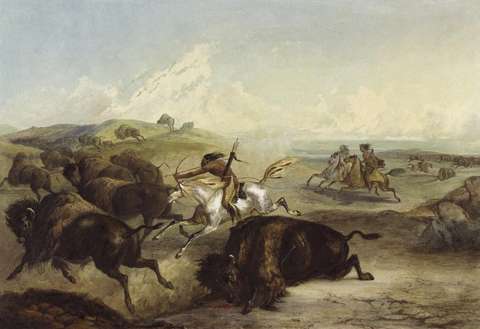
After the first white-Indian contacts, European-tribal trade was not always quick to develop, however. Wyoming State Archeologist Greg Pierce notes in his doctoral thesis that on the northern Plains, stone tools and weapons, including bows and arrows, “remained in use from the 17th through the 19th century.”
Art is not anthropology or archeology. Still, artists who visited the upper Missouri and Rocky Mountains in the 1830s noticed tribes hanging onto traditions or only selectively using European goods.
German artist Karl Bodmer made a sketch for his painting Indians Hunting the Bison, on Oct. 11, 1833, on a trip through the West with Prince Philipp Maximilian zu Wied-Neuwied. They were near Fort Union, in what’s now North Dakota, close to the confluence of the Missouri and Yellowstone rivers.
Nearly half a century after the introduction of the gun to the Plains tribes, Bodmer shows warriors riding horses with only skins for saddles, no European bridles or reins, and felling their prey with a traditional bow and arrow. All the items they used, except for the horses, were gained through self-acquisition or inter-tribal trade, not necessarily through commerce with Europeans.
In another Bodmer engraving from the same trip, “The Interior of the hut of a Mandan chief,” we see a mix of possessions, most of them native but also what may be a metal bowl at right and spears with what probably are metal spearheads.
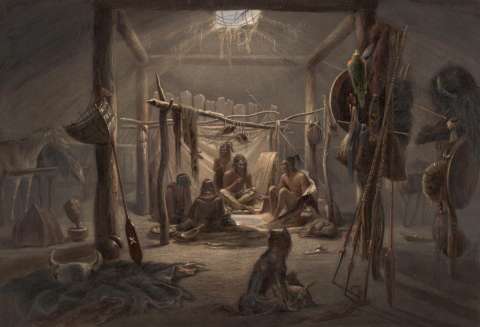
Alfred Jacob Miller, an American-born, European-trained artist also documented the tribes’ habit of selective use of what Europeans offered. Here, in Miller’s 1837 sketch, “Crossing to the North Fork of the Platte River,” we see Sioux in possession of guns and blankets but little else from the white culture.
As noted, these manufactured goods didn’t necessarily come into Indian hands directly from white traders. For example, Larocque met some of the Shoshone—whom he calls the Snakes—at these Knife River trade fairs and noted how they acquired goods, explaining in great detail how Indians could have European items through indirect trade:
The Snakes dwell east of the Flat heads upon the same range of mountains and on the head of rivers that have likewise a southerly course. They say there is much beaver on their lands and that they partly dress with it, they are all on good terms with the Rocky Mountains with whom they carry on such a trade as the Flat Heads. This nation is very numerous & each tribe has different names. The more southern tribes have dealings with the white of New Mexico from whom they get thick striped Blankets Bridles & Battle axes in exchange for Buffaloes robes and Deer Skins, but it is probable that this trade of the Snakes is carried on at a second or third hand and that they themselves have no direct trade with the Spaniards.
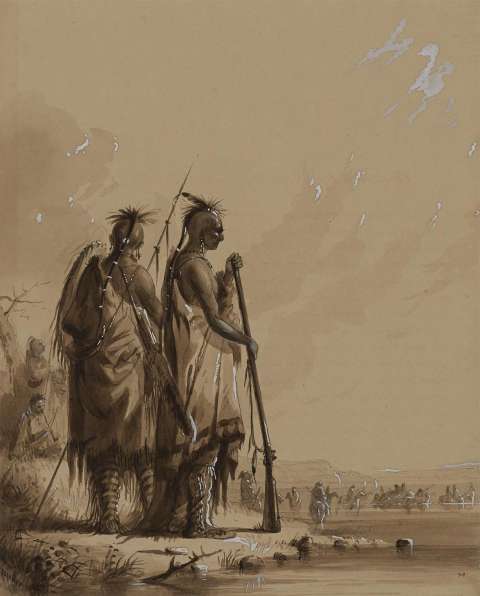
Horses, guns and disease
Tribes may have kept their distance from Europeans and stuck to their own ways, but contact with whites invariably altered tribe-to-tribe trade patterns. The horse, which came from the Spanish in the mid-17th century, allowed tribes to to expand their territories and become more efficient hunters and traders.
“The high tide in typical Plains culture seems to have come in the eighteenth and nineteenth centuries,” Clark Wissler writes in his often-quoted 1914 essay about the introduction of the horse to the Plains tribes. “While this was the era of trade, yet the horse increased the economic prosperity and created individual wealth with certain degrees of luxury and leisure; also it traveled ever ahead of the white trade and white trader.”
Yet modern-day scholars warn against assuming the horse totally rearranged trading patterns.
“This process of ‘indigenizing’ the horse may have resulted in the acceleration or intensification of traditional native activities, such as raiding and bison hunting, or cultural practices related to social and political stratification,” writes Wyoming State Archeologist Pierce. “However, there appears to be no reordering of indigenous worldviews as a result of the horse.”
The gun was another story. Until the invention of the repeating rifle, tribes preferred to hunt bison with traditional bows and arrows. They used guns in warfare, however. The gun, first introduced to Plains tribes in the early 18th century—Swagerty calls the exact date of its advent to the Plains tribes “fragmentary”—left the tribes dependent on Europeans for ammunition, gunpowder and repair.
“When the gun got to the tribes, it created problems,” says Gardner. “It created a dependency, including maintaining the rifle itself. That required a blacksmith.”
European-tribal trade also brought disease. Smallpox may have altered post-settlement Indian trade more than the gun or the horse. The 1837 Great Plains smallpox epidemic killed thousands people along the Missouri. Hardest hit were the Mandan. Historian Paul Carlson says that at the height of the culture, the Mandan had 15,000 people. After successive epidemics, ending with the smallpox epidemic of 1837, “only 138 people remained.”
The Rocky Mountain Fur Trade
As white intrusion became more common, the area that is now Wyoming played a more important role in Indian-to-European trade. The fur trade, which in Wyoming ran roughly from 1805-1840, involved numerous tribes. In 1824, Jedediah Smith, on a tip from the Crow, crossed South Pass and began trapping beaver on the Green River. Fort Laramie, built in 1834 at the confluence of the Laramie and North Platte rivers, served as a fur trading post. The same year, Antonio Montero built a trading post on the middle fork of Powder River about 11 miles east of present Kaycee.
The Green River Rendezvous, first held in 1825, attracted not only the Shoshone, but the Nez Perce, Ute, Flathead and other tribes. When the Oregon Trail started attracting significant emigrant traffic in the 1840s, local entrepreneurs—Indian and white—began doing business with the travelers. Veteran mountain men Jim Bridger and Louis Vasquez founded their trading post in 1843 on the Black’s Fork of the Green River—in the heart of Shoshone territory—to sell goods, livestock and blacksmithing services to the travelers. Bridger married Little Fawn, the daughter of Chief Washakie. Fort Bridger became for a time a large Shoshone community, with many eastern Shoshone spending much of the year in the area.
By 1854, there were small posts along the Oregon/California trail every 12 or 15 miles across what’s now Wyoming. These were mostly run by French-speaking men with native wives and families—predominantly Lakota Sioux in what’s now eastern Wyoming, Shoshone to the west.
The older tribe-to-tribe trading patterns, altered by disease, market hunting and the fur trade, began to fade away. In 1851, Commissioner of Indian Affairs Luke Lea promulgated a doctrine calling for the Indians' "concentration, their domestication, and their incorporation.” The reservation period had begun. Still, many held on to old ways. Swiss-born artist Rudolf Friedrich Kurz made reference to the Hidatsa trading corn to the Crow as late as 1851.
Trading–or at least the image of trading–hasn’t totally disappeared among tribes. In the movie Smoke Signals, written by Sherman Alexie, who grew up on the Spokane Reservation in northeast Washington State, characters Thomas Builds-the-Fire and Victor Joseph trudge along a highway, hoping for a lift. Two women from the reservation stop their car, asking if the men need a ride. “Yeah,” says Thomas Builds-the-Fire enthusiastically. One of the women in the car hesitates, then demands: “What are we goin’ to trade for it? We’re Indians, remember? We barter!”
Resources
Primary Sources
- Burpee, L.J., ed. Journal of Larocque from the Assiniboine to the Yellowstone, 1805. Publications of the Canadian Archives, no. 3. Ottawa, Canada: Government Printing Office, 1910. Accessed Feb. 19, 2016, at https://archive.org/stream/journaloflarocqu00laro/journaloflarocqu00laro_djvu.txt.
- Gardner, Dudley, Interview, February 2, 2016
- Kurz, Rudolph Friederich. 1937. Journal of Rudolph Friederich Kurz, ed. J. N. B. Hewitt, trans. Myrtis Jarell, Bulletin of the Bureau of American Ethnology, no. 115 , page 198. Washington, 1937.
- Lea, Luke. Cited in a 1948 US Department of the Interior document, Handbook of Federal Indians Laws, edited by Felix Cohen, Page 14. Accessed April 6, 2016 at: https://books.google.com/books?id=n8tGAQAAIAAJ&pg=PA14&lpg=PA14&dq=Commissioner+of+Indian+Affairs+Luke+Lea,++domestication&source=bl&ots=GMWchXQqCr&sig=INpTiCdxrcPOg6MtFJUF-YVzC9A&hl=en&sa=X&ved=0ahUKEwjorvqnnPrLAhXCmoMKHdsxAdIQ6AEIOzAG#v=onepage&q=Commissioner%20of%20Indian%20Affairs%20Luke%20Lea%2C%20%20domestication&f=false
- Wood, W. Raymond, and Thomas D. Thiessen. Early fur trade on the Northern Plains: Canadian traders among the Mandan and Hidatsa Indians, 1738-1818 : the narratives of John Macdonell, David Thompson, François-Antoine Larocque, and Charles McKenzie. Norman: University of Oklahoma Press, 1985, 221-296.
- Russell, Osborne. Journal of a Trapper: Or, Nine Years in the Rocky Mountains, 1834-1843, 31. Accessed March 16, 2016, at https://books.google.com/books?id=49HTAAAAMAAJ&pg=PR3&source=gbs_selected_pages&cad=3#v=onepage&q&f=false.
- Niobrara County Library. “Roundup of 1884, by Addison A. Spaugh,” Lusk Free Lance, May 17, 1934, 1. Accessed Feb. 19, 2016, at http://www.niobraracountylibrary.org/history/?id=142. This newspaper can also be accessed at Wyoming Newspapers at http://newspapers.wyo.gov.
- Wood, W. Raymond, professor emeritus of anthropology at the University of Missouri. Email to the author, February 6, 2016
Secondary Sources
- Carlson, Paul. The Plains Indians. College Station, Texas: Texas A & M University Press, 1998, 8.
- Davis, Leslie B., Stephen A. Aaberg, James G. Schmitt and Ann M. Johnson. The Obsidian Cliff Plateau Prehistoric Lithic Source, Yellowstone National Park, Wyoming.
- Accessed Feb. 19, 2016, at http://www.blm.gov/style/medialib/blm/wo/Planning_and_Renewable_Resources/coop_agencies/cr_publications.Par.85037.File.pdf.
- Ewers, John C. 1954. “The Indian Trade of the Upper Missouri Before Lewis and Clark: An Interpretation.” Bulletin of the Missouri Historical Society 10 (4):429-446.
- Gade, Gene. “The Spanish Diggings.” Vore Buffalo Jump Foundation. Accessed March 16, 2016 at http://www.vorebuffalojump.org/pdf/VBJ-Spanish%20Diggings.pdf.
- Hodge, Fredrick. Handbook of American Indians North of Mexico. Volume 1, Volume 30, Part 1. Government Printing Office, Washington. D.C.,1907.
- Keoke, Emory Dean and Kay Marie Porterfield. Encyclopedia of American Indian Contributions to the World: 15,000 Years of Inventions and Innovation. New York: Checkmark Books, July 2003, 3.
- Knight, Wilbur, C. “Prehistoric Quartzite in Central Eastern Wyoming.” Science.7, no. 166 (1898): 310.
- Pierce, Greg. Re-examining Contact on the High Plains and Rocky Mountain Regions of the West, Ph.D. diss., University of Wyoming, 2015.
- Ronda, James P. “The Arikara Interlude.” Lewis & Clark Among the Indians, The Journals of the Lewis and Clark Expdition. Accessed April 19, 2016 at http://lewisandclarkjournals.unl.edu/read/?_xmlsrc=lc.ronda.01.03.xml.
- Swagerty, William. Indian Trade in the Trans-Mississippi West to 1870. In the Handbook of North American Indians: History of Indian-White Relations, ed. by William C. Sturtevant. Washington, D.C.: Smithsonian Institution, U.S. Government Printing Office, 1988, 286, 353.
- Wikipedia. “Indian Trade.” Accessed Feb. 19, 2016, at https://en.wikipedia.org/wiki/Indian_Trade.
- Wissler, Clark. “The Influence of the Horse in the Development of Plains Culture.”
- American Anthropologist, 16, no. 1 (January-March, 1914): 1-23.
- Wood, W. Raymond. Prologue to Lewis and Clark: The Mackay and Evans Expedition. Norman, Okla.: University of Oklahoma Press, 2003, 26.
Illustrations
- Wilbur Knight’s 1894 photo of Spanish Diggings is from the Samuel H. Knight Collection at the American Heritage Center via Wyoming Places. Used with thanks.
- The Indian trade map was created by Dr. Raymond Wood, professor emeritus of anthropology, University of Missouri, for his book, Anthropology on the Great Plains, which he edited with Dr. Margo Liberty. Used with his kind permission.
- Karl Bodmer, Indians hunting the bison. Tableau 31, is found in Maximilian zu Wied-Neuwied’s Maximilian Prince of Wied’s Travels in the Interior of North America, during the years 1832–1834; Translation H. Evans Lloyd; Achermann & Comp., London 1843–1844. This image is from Wikipedia. Used with thanks.
- The image of Karl Bodmer’s aquatint, "The interior of the hut of a Mandan Chief" from Maximilian, Prince of Wied’s book, Travels in the Interior of North America, during the years 1832–1834 is from Wikipedia. Used with thanks.
- The image of Alfred Jacob Miller’s sketch of the two Sioux warriors from the Walters Art Museum in Baltimore. Used with thanks. Patron William Walters commissioned Miller to do a series of 200 watercolors of Rocky Mountain life; Miller based them on sketches he had made on his 1837 trip to the fur trade rendezvous on Green River. “At these crossings,” Miller writes in his caption, “our goods were placed on Bull Boats ... A number of Sioux were watching our operations all this time, statue-like on the banks, and although we offered them strong inducements to help us, nothing would move them. We fancied we saw an expression of contempt on their faces. The trappers, becoming enraged, launched at them the choicest anathemas in French. 'Nursing their wrath to keep it warm.' Luckily for the poor Indians, they understood not a word of these nice expletives, and certainly so far as quiet dignity was concerned, they had the best of it."
